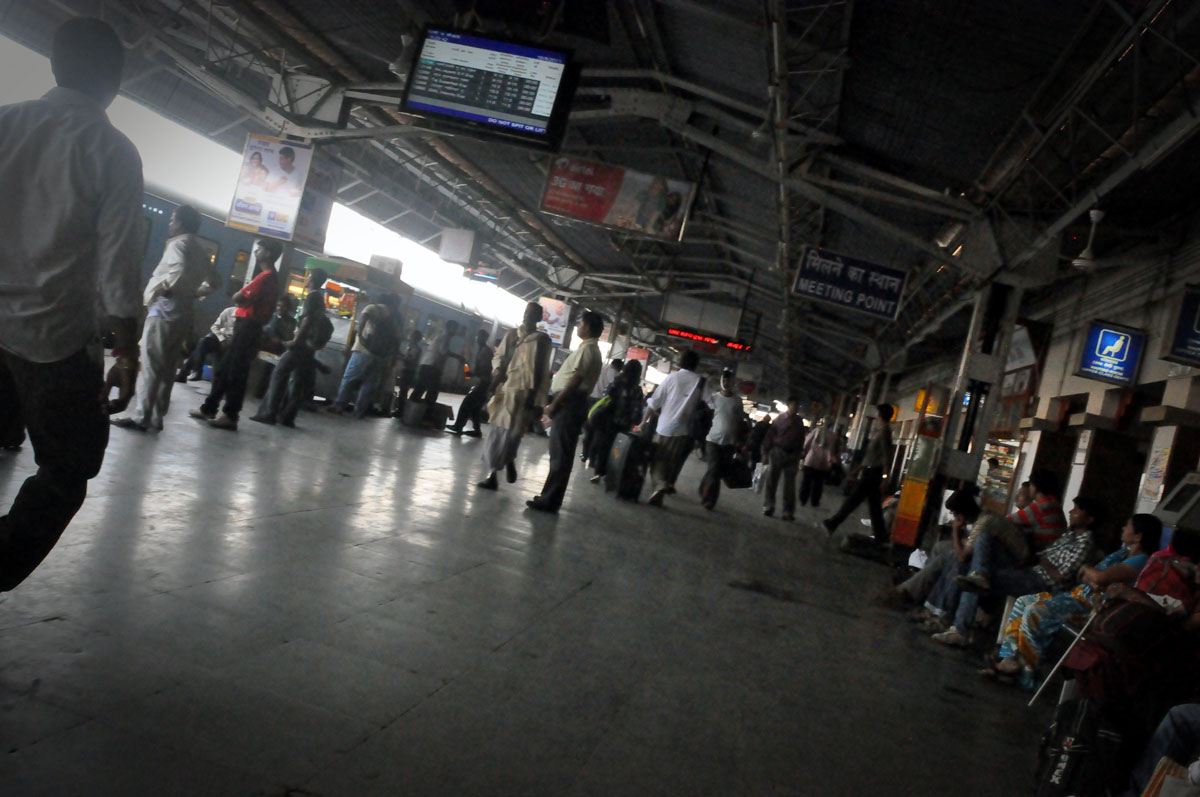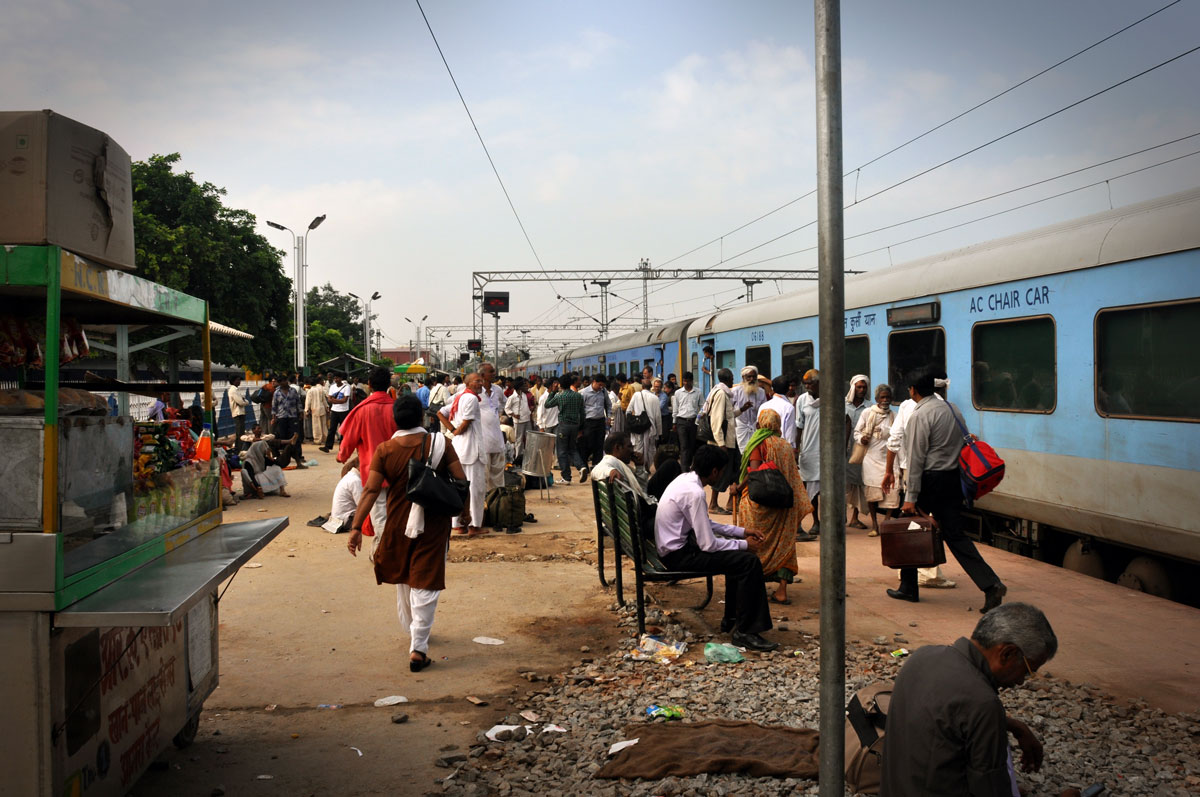Contributed by Stephanie Chin Whitesel
It was sometime after dark when some friends and I were standing on the platform of the Agra train station, waiting to catch our train to New Delhi. We had just come from seeing the Taj Mahal, the symbol of India. Debatably one of the world’s most opulent architectural achievements, it graces the covers of countless tourism magazines and posters. We had been awed by its tons of white marble, inlaid with jewels and coral imported from around the globe. The gardens were equally spectacular, green and flourishing despite the intense rays from the sun. Serving as both a monument and a mausoleum, the area was quiet and peaceful, commanding a certain amount of respect from its visitors.
My friends and I were standing in a circle, discussing the Taj and all of its glory. We stood close together in order to discourage the many vendors and beggars from getting too near. Often they would approach us with one hand outstretched, using the other to make a motion to their mouths. We had learned to ignore the pleas of the Indian people. Sadly, no matter how gracious or compassionate a single person may be, one simply cannot donate to every needy person that they run into in India. A person’s funds would be exhausted too quickly and thoroughly without even coming close to providing the type of assistance that could genuinely offer long-term help.
Earlier, as we stepped outside the gated area that fully enclosed the Taj from the outside world, we had been swarmed by vendors trying to sell us postcards, figurines, jewelry, and clothing. We got pushed around and yelled at and, in the end, the boys in the group ended up holding back the crowd to allow the girls to board a bus. Unable or unwilling to buy the items, we learned that the quickest way to make them retreat to their next hopeful sale was to completely ignore them, not replying to their queries and certainly not making eye contact. We were afraid of being overwhelmed once again. Thus, at the station, we were doing our best to ignore a little boy cupping his hands together and reaching them out to us.
He was probably about seven or eight years old. His brown hair was long, dirty, and tousled, while his clothing was gray from age and thin from wear. The boy’s bone structure was clearly pronounced through his smooth, dark skin and his teeth were yellowed and already starting to show significant orthodontic problems. I’m not sure if he spoke English or not, for he simply tapped our arms or tugged on our backpacks in an attempt to get us to pay attention to him.
His efforts did not go unnoticed and we tried our hardest to not react to his silent pleas. Yet, we weren’t the only ones aware of the boy’s presence. Two officials briskly walked toward our group. Dressed in camel-colored uniforms, each one carried a long, thick pole of bamboo. They began to hit the boy. There was no warning. This wasn’t a gentle tap or a push. It was an unforgiving smack. One official was aiming for the boy’s legs while the other went for the lower back.
There was a loud gasp, though I’m still not sure whether it came collectively from the group or merely from me. I was so surprised by what was happening that I didn’t have a chance to move before the little boy scrambled away from the men to avoid any further blows. He ran and hid behind me, as I was closest to him, and he hugged my leg. The guard scowled at the boy and adjusted his grip on the bamboo. In that moment, I thought the guard was going to hit me, just so he could make his way to the little boy.
Instinctively, I flinched. I have long since learned that my emotional response is neither fight nor flight. It is freeze and panic. As I flinched and turned my head, I locked eyes with the little boy cowering behind me.
There’s a cliché that claims that the eyes are the window to the soul. This boy had eyes that were the color of cocoa, bright and wide, taking in too many of the harsh realities of his world. He looked tired, hungry, and a little scared. However, he was not surprised. This scenario had happened countless times before. It wasn’t unusual for the officials to hit him in his efforts to get food or money from travelers. It was a common ritual.
Noting that the officials had taken a few steps away, the boy took the opportunity to sprint away. His short, quick strides carried him out of the train station. The people I was with grew very quiet. None of us knew what to do or say next. Clearly none of us were comfortable with that has just happened. During this awkward silence, I peered around.
The station in Agra is no Grand Central. No polished marble, no elaborate looking time pieces, and no frescoed ceiling. Instead, the stairs, walls, platform, and pillars are all just gray, utilitarian concrete. People were gathered outside the perimeter of the station, wordlessly stretching out their hands to passersby, hoping for an act of charity. Others slept close together, lying close under whatever shelter the overhang on the roof could provide. Vendors rolled around creaking wooden carts full of figurines, magazines, and trinkets. Despite the late hour, the station was busy with passengers who walked to and fro searching for lost children, correct trains, and toilets. Everything was covered with a thin layer of dust or dirt — the workers, the vendors, the platform, the waiting passengers, and myself.
Despite the efforts to shield me from it, I saw reality. After watching the hundreds of people outside lie down in rows to sleep for the night and watching a fight break out over a decomposing pomegranate, I realized that the train station was a more pertinent symbol for India than the Taj Mahal. The Taj Mahal merely showed me a sparkling existence courtesy of royalty who lived hundreds of years ago. Yeah, I took dozens of photos of the Taj Mahal from every imaginable angle. I marveled at its scope and grandeur. Yet, even ten years later, it is that train station in Agra that left the deepest impact.

Agra Train Station inside

Agra Train Station outside
Photos: ‘India – Agra – 001’ by McKay Savage, ‘Agra Train Station’ and ‘The Agra Train Station’ by Will.
